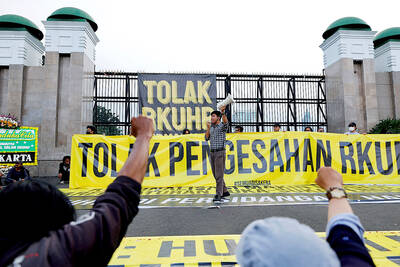Scientists in Japan would try to grow human organs in animals after receiving government permission for the first study of its kind in the country.
The cutting-edge — but controversial — research involves implanting modified animal embryos with human “induced pluripotent stem” (iPS) cells that can be coaxed into forming the building blocks of any part of the body.
It is the first step in what researchers caution is a long path toward a future where human organs for transplant could be grown inside animals.
The research led by Stanford University genetics professor Hiromitsu Nakauchi is the first of its kind to receive government approval after Japan changed its rules on implanting human cells into animals.
Japan had previously required researchers to terminate animal embryos implanted with human cells after 14 days and prevented the embryos from being placed into animal wombs to develop.
However, those restrictions were dropped in March, allowing researchers to seek individual permits for research projects.
“It took nearly 10 years, but we are now able to start the experiment,” Nakauchi said.
The research involves generating animal embryos — mice, rats or pigs — that lack a particular organ such as a pancreas.
The modified embryos are then implanted with human iPS cells that can grow into the missing pancreas.
The embryos would be transplanted into wombs where they could theoretically be carried to term with a functioning human pancreas.
Preliminary research has produced some promising signs, including the successful growth of mice pancreases in rats.
The pancreases, when transplanted back into mice, functioned successfully and controlled blood glucose levels in diabetic mice.
However, other tests have been more complicated: Researchers were able to grow mice kidneys in rats, but rat stem cells implanted in mice failed to take.
Even though the mice kidneys developed properly in rats, the rats died shortly after birth because of complications related to the way that they were modified before receiving the mice stem cells.
Nakauchi said that the newly approved study would help understand the obstacles in the field, and cautioned that he was far from the eventual goal of trying to grow human organs in pigs.
“Although we have shown proof-of-concept studies using rodent models, to overcome the genetic distance between human and pig is not easy,” he said. “The study is just about to begin. Do not expect that we are generating human organs in a year or two.”
Implanting animal embryos with human cells creates what is known as a chimera — an entity with both animal and human cells.
The process throws up complex ethical issues, particularly over concerns that it might not be possible to completely control which organs are formed in the animal by the human iPS cells.
Rules on the process differ by country: The US has no federal restrictions on creating chimeras, while other countries prohibit chimeras being kept alive beyond two weeks.
Ethicists fear that chimeras with human brain or reproductive cells would pose serious questions about the nature of the animal being tested.
Nakauchi said that his team would be proceeding with extreme caution given the ethical concerns.
“At each step we examine embryos for the presence of human cells in the brain,” Nakauchi said. “After confirming the absence or few human cells, we go to the next step.”

Indonesia yesterday began enforcing its newly ratified penal code, replacing a Dutch-era criminal law that had governed the country for more than 80 years and marking a major shift in its legal landscape. Since proclaiming independence in 1945, the Southeast Asian country had continued to operate under a colonial framework widely criticized as outdated and misaligned with Indonesia’s social values. Efforts to revise the code stalled for decades as lawmakers debated how to balance human rights, religious norms and local traditions in the world’s most populous Muslim-majority nation. The 345-page Indonesian Penal Code, known as the KUHP, was passed in 2022. It

US President Donald Trump on Friday said Washington was “locked and loaded” to respond if Iran killed protesters, prompting Tehran to warn that intervention would destabilize the region. Protesters and security forces on Thursday clashed in several Iranian cities, with six people reported killed, the first deaths since the unrest escalated. Shopkeepers in Tehran on Sunday last week went on strike over high prices and economic stagnation, actions that have since spread into a protest movement that has swept into other parts of the country. If Iran “violently kills peaceful protesters, which is their custom, the United States of America will come to

Auschwitz survivor Eva Schloss, the stepsister of teenage diarist Anne Frank and a tireless educator about the horrors of the Holocaust, has died. She was 96. The Anne Frank Trust UK, of which Schloss was honorary president, said she died on Saturday in London, where she lived. Britain’s King Charles III said he was “privileged and proud” to have known Schloss, who cofounded the charitable trust to help young people challenge prejudice. “The horrors that she endured as a young woman are impossible to comprehend and yet she devoted the rest of her life to overcoming hatred and prejudice, promoting kindness, courage, understanding

‘DISRESPECTFUL’: Katie Miller, the wife of Trump’s most influential adviser, drew ire by posting an image of Greenland in the colors of the US flag, captioning it ‘SOON’ US President Donald Trump on Sunday doubled down on his claim that Greenland should become part of the US, despite calls by the Danish prime minister to stop “threatening” the territory. Washington’s military intervention in Venezuela has reignited fears for Greenland, which Trump has repeatedly said he wants to annex, given its strategic location in the arctic. While aboard Air Force One en route to Washington, Trump reiterated the goal. “We need Greenland from the standpoint of national security, and Denmark is not going to be able to do it,” he said in response to a reporter’s question. “We’ll worry about Greenland in